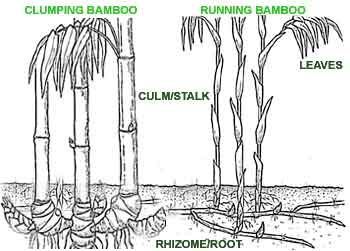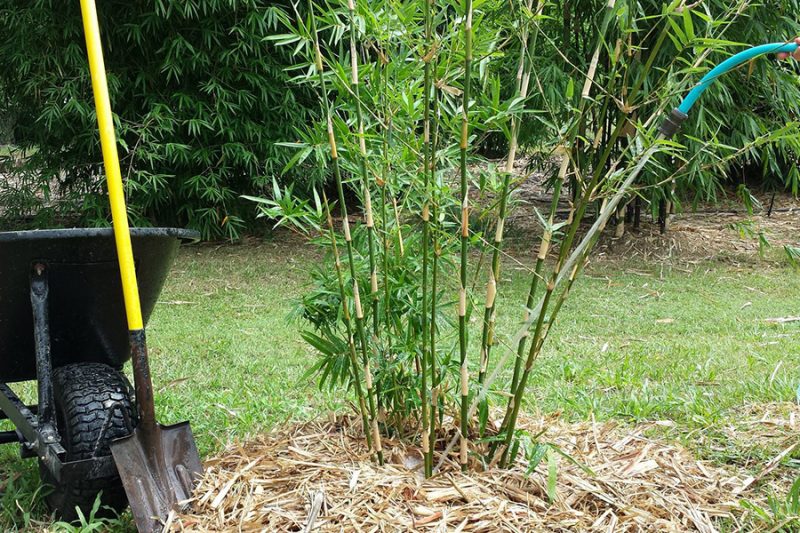Bamboo Care and Maintenance
Bamboo was once considered an exotic plant for gardens but in recent years many gardeners have recognized it as a robust and versatile addition to a home garden. These characteristics make bamboo well suited not only ornamental purposes but also highly functional as hedging. Bamboo grows thick, fast and can quickly add lush and vibrant foliage to your garden.
Like all cultivars, proper selection must be made for garden conditions and consideration made for growth rate, eventual size and individual variety characteristics. While dwarf varies like Sasa Veichii and Pleioblastus Pumilus reach a final height of 1-2 meters, Phyllostachys Vivax can grow up to 18 m (60 ft) in a growing season. Our bamboo varieties are very cold tolerant (H5 and higher) and are especially well suited for UK cultivation. Bamboo can prosper in most soil types providing for proper drainage.

 Bamboo is generally distributed into two categories: running bamboo and clumping bamboo. As a rule of thumb for full size and giant varieties, clumping types gain 1-2 ft of height per year while running types gain 3-5 ft per year and sideways spread is roughly equivalent.
Bamboo is generally distributed into two categories: running bamboo and clumping bamboo. As a rule of thumb for full size and giant varieties, clumping types gain 1-2 ft of height per year while running types gain 3-5 ft per year and sideways spread is roughly equivalent.
Once the root system is provided an environment to properly establish, bamboo care and maintenance is simple and easy. Your new bamboo will add a vibrant texture to your garden and add both aesthetic character and practicality to your garden.
 Bamboo Planting Advice
Bamboo Planting Advice
All of our bamboo is potted and has strong roots, but there are some seasonal recommendations for planting. Spring and autumn planting is generally preferred, for summer planting make sure to water adequately and mulch heavily if being planted late in the year. Bamboo for gardening purposes is generally sorted into two categories; clumping bamboo and running bamboo. While clumping bamboo is easily managed, running bamboo must be contained with a rhizome barrier to prevent spreading. Like all new plants, keep the root ball well hydrated (but not water logged) up until the day of planting.
Plant Spacing
- Plant height 50-100cm (20-40in) -recommended 6 plants per linear meter
- Plant height 100-150cm (40-60in) -recommended 4 plants per linear meter
- Plant height 150-200cm (60-80in) -recommended 3 plants per linear meter
- Plant height 200-250cm (80-100in) -recommended 2 plants per linear meter
- Plant height 250-300cm (100-120in) –recommended 1-2 plants per linear meter
- Plant height 300-350cm (120-140in) –recommended 1-2 plants per linear meter
The majority of bamboo varieties will not suffer from back to back planting, but this may slow the growth rate. As a rule of thumb for full size and giant varieties, clumping types gain 30-60cm (1-2 ft) of height per year while running types gain 90-150cm (3-5 ft) per year and sideways spread is roughly equivalent.
Ground Preparation
For running bamboo, construct a barrier using HDPE plastic sheet preferably 80mm gauge and 80cm (30in) deep. For either type, remove all vegetation from the immediate planting area.

 Day of planting
Day of planting
- Dig a hole twice the size of the root ball and 1.5 times as deep, and place the soil on a gardening tarp, use Planting Compost and mix it in 50/50 with the native soil, consider amending Horticultural Gravel if working with a heavy soil to increase drainage. Make sure to remove any large rocks and break up any clumps.
- Place new compost at the bottom of the hole to improve drainage, consider amending Horticultural Gravel if working with a heavy soil to increase drainage.
- Remove the rootball from the shipping container and unfurl any circled roots and gently unfurl and tease out from the bottom edges of the root mass.
- Place the bamboo in the hole with the top of the root-mass at ground level.
- Place the backfill into the hole until ground level while packing the soil around the root ball so they stay in an upright position. Water the hole regularly while you are placing in the backfill to eliminate any air pockets. Remember that you want to pack in the backfill, not stamp down into the hole. Water the soil thoroughly after planting but do not waterlog.
- Place a 5-8cm (2-3in) layer of Mulch or Compost over the planting area to help retain moisture and deter weeds.

Growing Bamboo in Containers
When considering a planting or trough for bamboo, select one with proper drainage that is 20% larger than the shipping container and remember that every 2-5 years it will have to be re-potted or divided due to growth. Bamboo in containers are more susceptible to environmental stress and will require more care. A well-established bamboo will require watering 3-5 times a week in the summer and is more susceptible to the cold in the wintertime. Place a screen over the drainage holes to prevent clogging and add a bottom 1/3 layer of Horticultural Gravel to the container to improve drainage and keep a low centre of gravity as the plant can become top heavy and spill in high winds, but place a layer of compost over the gravel so the roots do not directly touch the gravel. Centre the bamboo in the container and gradually fill in with Planting Compost while firming up the sides until just slightly covering the rootball. Topdress as desired.
Water your new bamboo 2-3 times per week for the first month after planting and once per week thereafter. These steps will provide a nourishing environment the bamboo roots to establish and thrive in your garden.
Bamboo Trimming Advice
Like all plants bamboo requires some pruning to limit growth and maintain attractiveness. Once each year remove the older, unattractive culms and remove any dead branches. Bamboo can be trimmed without being damaged, cut just above the node so as not to leave an unsightly stub. If you are lopping off the top to limit size also tighten up some of the side branches for a more balanced appearance, not leaving the longer branches at the top.
Bi-annual root trimming around the edge of running bamboo is effective for controlling growth. Rhizome growth is shallow 5-12cm (2-5in), work around the base with a spade and sever wayward rhizomes completely about 60cm (2ft) or wherever growth is desired. Completely sever rhizomes that are found outside of designated areas, but leave the core rhizome attached for new shoots in the spring.
With a minimal yet effective amount of maintenance, your new bamboo plant will give your garden texture and character.
Bamboo Watering Advice
For best results, an automatic irrigation system is recommended. Regular watering 2-3 times per week for the first month is important for root establishment, and subsequent weekly watering for the first year and during extended dry spells in the summer the following years.
Regular watering after planting will allow the roots to properly establish resulting in a healthy plant that will last for decades.
Bamboo Feeding Advice
Bamboo likes a high nitrogen fertilizer (ie. 20-5-5) in the mid to late spring followed by a layer of fresh mulch 5-8cm (2-3in) after it is absorbed into the ground about 250 g (1/2 pound) per 30 Sq. m (100 Sq. ft). Falling leaves will make wonderful compost after this spring layer and do not need to be removed.
Apply a fresh layer of mulch in late fall 5-8cm (2-3in) to keep the roots warm in the winter.
Bamboo is low maintenance plant that will thrive in your garden for decades with minimal yet effective care


